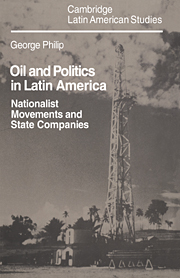Book contents
- Frontmatter
- Contents
- List of tables
- Preface
- Glossary
- Abbreviations
- Note on currencies and other units of measurement
- Maps: Latin America in 1920, 1940, 1960 and 1981; showing importing countries, exporting countries and countries self-sufficient in oil
- Introduction: The politics of oil in twentieth-century Latin America
- Part I The world oil environment
- Part II The major expropriations
- Part III The state oil companies
- 17 Pemex in Mexican politics 1938–79
- 18 The development of Petrobrás: oil company to conglomerate?
- 19 ypf 1932–1979: public enterprise or bureaucracy?
- 20 Petroperú 1968–80: achievements and hard lessons
- 21 ypfb and the development of oil in Bolivia
- 22 Petrovén: the birth of a giant
- 23 State oil companies in Latin America
- 24 Concluding reflections
- Notes and bibliography
- Index
- CAMBRIDGE LATIN AMERICAN STUDIES
22 - Petrovén: the birth of a giant
Published online by Cambridge University Press: 23 December 2009
- Frontmatter
- Contents
- List of tables
- Preface
- Glossary
- Abbreviations
- Note on currencies and other units of measurement
- Maps: Latin America in 1920, 1940, 1960 and 1981; showing importing countries, exporting countries and countries self-sufficient in oil
- Introduction: The politics of oil in twentieth-century Latin America
- Part I The world oil environment
- Part II The major expropriations
- Part III The state oil companies
- 17 Pemex in Mexican politics 1938–79
- 18 The development of Petrobrás: oil company to conglomerate?
- 19 ypf 1932–1979: public enterprise or bureaucracy?
- 20 Petroperú 1968–80: achievements and hard lessons
- 21 ypfb and the development of oil in Bolivia
- 22 Petrovén: the birth of a giant
- 23 State oil companies in Latin America
- 24 Concluding reflections
- Notes and bibliography
- Index
- CAMBRIDGE LATIN AMERICAN STUDIES
Summary
By the beginning of 1976, when Petrovén formally came into being, the Venezuelan oil industry was in a technical sense already showing signs of age. In 1970, 2.7 of the 3.7 million daily barrels of oil produced came from six fields. These were Lagunillas, Tía Juana, Bachaquero, Lama, Lamar and Centro, discovered in 1926, 1928, 1930, 1937, 1938 and 1959 respectively. All of these were in the area of Lake Maracaibo and all were onshore; there was significant oil production from the east of the country but offshore work had hardly begun. Until large-scale new oil discoveries could be made, it was the job of the new state company to keep the oil flowing from these fields for as long as possible. This required increasingly sophisticated recovery work and, thus, some continuing reliance on the main international centres of technology.
At the same time, the nationalisation took place when the international balance of oil power was moving sharply away from the companies and consumer interests to the governments of oil-exporting countries. Naturally there were advantages for Venezuela in this process. There were also important policy decisions to be made as Venezuela moved away from the protective shelter of technical and marketing agreements with the foreign companies which had been carefully constructed as part of the nationalisation. The nationalisation also raised political questions: how would the creation of a public enterprise of such size and economic power affect Venezuelan democracy?
- Type
- Chapter
- Information
- Oil and Politics in Latin AmericaNationalist Movements and State Companies, pp. 469 - 480Publisher: Cambridge University PressPrint publication year: 1982



